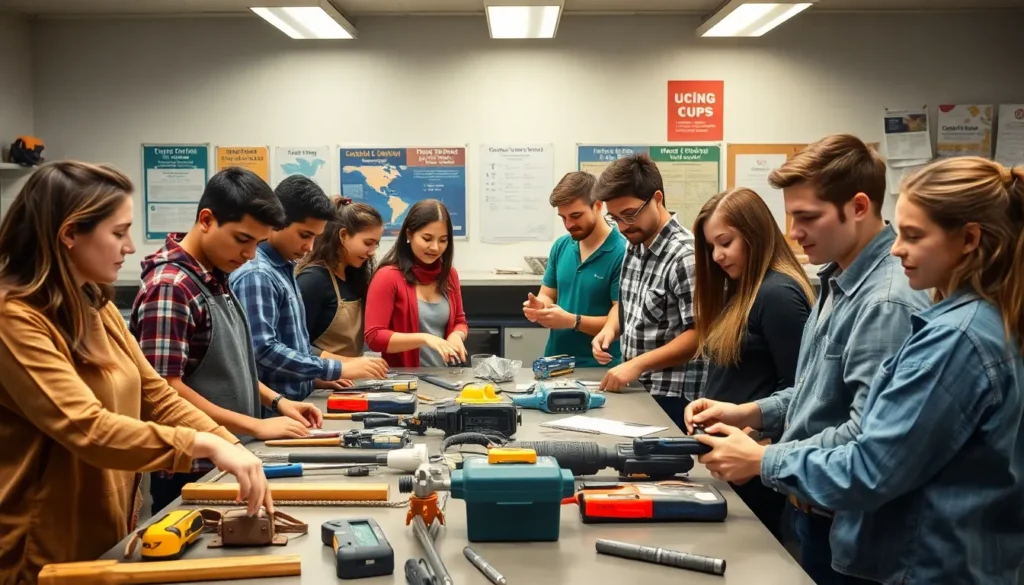As the clock ticks toward 2025, a shadow looms over Job Corps, the beloved program that’s helped countless young people find their footing in the workforce. Picture this: a bustling hub of eager learners, crafting futures and mastering skills, suddenly facing an unexpected exit. It’s like watching your favorite sitcom get canceled—just when things were getting good!
Table of Contents
ToggleOverview of Job Corps
Job Corps serves as a vital program aimed at helping young individuals, particularly those facing economic challenges, develop essential workforce skills. Launched in 1964, it provides vocational training, academic support, and life skills education to participants aged 16 to 24. Geographic distribution spans across the United States, offering programs in urban and rural areas.
Training options include fields such as healthcare, construction, hospitality, and information technology. Participants receive hands-on experience that bolsters their resumes and enhances employability. The program also emphasizes personal development, including financial literacy and conflict resolution, equipping individuals for successful transition into adulthood.
Job Corps operates through various centers where students engage in a structured environment. Each center tailors its programs to meet local job market demands. Numerous success stories highlight the program’s effectiveness in empowering at-risk youth and enabling them to secure stable employment.
Support services offered by Job Corps extend beyond mere education. Counseling, mentorship opportunities, and assistance with job placements are integral components aimed at fostering success. The dedication to transforming lives has positioned Job Corps as a crucial federal initiative in combating youth unemployment.
As 2025 approaches, concern grows about the future viability of Job Corps. Discussions regarding budget cuts and program restructuring raise questions about its sustainability. Stakeholders advocate for maintaining funding to preserve its benefits for vulnerable populations. The potential closure of such a resource could drastically affect millions of young individuals seeking opportunities.
Impact of Job Corps Closing Down 2025

The closing of Job Corps in 2025 poses significant consequences for youth employment and broader community dynamics.
Effects on Youth Employment
Youth unemployment could rise sharply as Job Corps phases out its services. Many young individuals depend on the program for training in fields like healthcare and construction. It equips them with valuable skills, enhancing employability in competitive job markets. The potential loss of these resources means fewer job placements, jeopardizing opportunities for economically disadvantaged youth. Without access to vocational training and life’s skills education, many may struggle to transition smoothly into adulthood. Overall, the elimination of Job Corps threatens not just immediate job prospects but also long-term career development for countless young people.
Community Consequences
Communities could face increased economic struggles as Job Corps closes its doors. Local economies often benefit from the program by providing trained workers who fill vital roles. Disruption in this workforce pipeline may lead to labor shortages in sectors that rely on skilled labor. Additionally, youth disengagement from the workforce can result in higher rates of unemployment, straining community resources and support systems. Support services and mentoring provided by Job Corps play essential roles in addressing social issues. Their absence could exacerbate problems such as crime and poverty within struggling communities. The toll on infrastructure, social services, and overall community health could be substantial.
Alternatives to Job Corps Programs
As Job Corps faces closure in 2025, various alternatives offer similar support for youth. These options ensure that young individuals continue to receive necessary training and resources for successful careers.
Other Vocational Training Options
Local community colleges provide vocational training tailored to regional job markets. Many colleges offer certificate programs in fields like healthcare, culinary arts, and information technology. Online platforms also present flexible learning opportunities, featuring courses on digital marketing, coding, and graphic design. Nonprofit organizations often run workshops that teach practical skills, focusing on trades like plumbing and electrical work. States may even sponsor apprenticeships that combine classroom instruction with hands-on experience in selected industries.
Community Support Initiatives
Youth mentoring programs connect young people with professionals, guiding them through career paths and skill-building activities. Local organizations sometimes coordinate job fairs, aiding youth to meet potential employers and explore job openings. Community centers frequently host free workshops on financial literacy and resume writing, enhancing job readiness. Partnerships between schools and local businesses can create internship opportunities, offering real-world experience. In addition, workforce development boards may provide funding for training programs that cater to the needs of underserved populations.
Future of Workforce Development
The potential closing of Job Corps creates a significant gap in workforce development for young individuals. Alternatives to Job Corps emerge as key players in ensuring continued support for youth. Local community colleges offer vocational training geared towards regional job markets.
Certificate programs in healthcare and information technology prepare students for in-demand occupations. Online platforms present flexible learning opportunities, giving participants the chance to study at their own pace. Nonprofit organizations also play a role by running workshops that teach practical skills in various trades.
Mentorship is crucial for fostering connections between young people and professionals. Programs that provide guidance can influence career choices positively. Community initiatives, such as job fairs and internships, enhance job readiness by offering real-world experience.
Workforce development boards provide necessary funding for training programs targeting underserved populations. This approach helps maintain access to essential resources for aspiring workers. As exploration of alternative solutions continues, collaboration among educational institutions, nonprofits, and government agencies remains vital.
Overall, the landscape of workforce development may shift significantly, but with focused efforts, it can adapt to meet the needs of youth. Strategic partnerships will support successful transitions into the workforce, ensuring that skills training persists in the face of impending changes.
The impending closure of Job Corps in 2025 raises critical concerns for the future of youth workforce development. As this vital program phases out, young individuals may face increased barriers to employment and skill acquisition. The potential rise in youth unemployment could have far-reaching implications for communities, affecting economic stability and social cohesion.
While alternatives are emerging to fill the void left by Job Corps, the effectiveness of these options remains to be seen. Continued collaboration among educational institutions, nonprofits, and government agencies is essential to ensure that young people receive the support they need. The future of workforce development hinges on proactive measures to safeguard opportunities for the next generation, ensuring they have the tools to succeed in an evolving job market.





